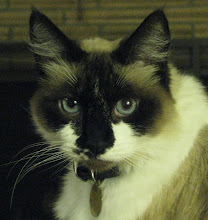But I did finally attack one of the fabric pieces I discharged in Jeannette's workshop several months ago. What I did originally was apply a thickened bleach solution to a piece of salmon-colored fabric using squeeze bottle and bubblewrap. It was purely an experiment; I
 didn't think much about the composition at all. Later, at home, I brushed the fabric here and there with a dilute solution of turquoise Procion dye. Dang; blew it. I hated the results. But I liked the color combination, and decided to use the discharge pattern as a loose guide for some reverse applique. (For the non-quilters: applique = layering a cut-out shape of another fabric on top of the main piece and sewing it on. Reverse applique = layering a chunk of different fabric under your main piece, stitching an outline of the desired shape on top, then taking a sharp pair of scissors and skillfully cutting away the top layer within the stitching lines to reveal the underlying fabric.) I enjoy reverse applique because the result is always somehow surprising.
didn't think much about the composition at all. Later, at home, I brushed the fabric here and there with a dilute solution of turquoise Procion dye. Dang; blew it. I hated the results. But I liked the color combination, and decided to use the discharge pattern as a loose guide for some reverse applique. (For the non-quilters: applique = layering a cut-out shape of another fabric on top of the main piece and sewing it on. Reverse applique = layering a chunk of different fabric under your main piece, stitching an outline of the desired shape on top, then taking a sharp pair of scissors and skillfully cutting away the top layer within the stitching lines to reveal the underlying fabric.) I enjoy reverse applique because the result is always somehow surprising. So I seamed a piece of medium-turquoise hand-dyed Kona cotton to a piece of dark turquoise silk that used to be part of a jacket lining (thanks again, Francine) and used this as the backing fabric. Some freemotion quilting, some snipping, and... it looked like a dropcloth that had been folded down the middle while wet, then unfolded. Better vertically, maybe, kind of a sky-sea suggestion? Nah, not really. I considered overlaying portions with organza or another translucent fabric to get some movement, some kind of interest, going. Or maybe chopping it up, just treating the fabric as background, and piecing it together with a strong design element -- for some reason I'm picturing a heavily skewed X shape -- in the foreground.
So I seamed a piece of medium-turquoise hand-dyed Kona cotton to a piece of dark turquoise silk that used to be part of a jacket lining (thanks again, Francine) and used this as the backing fabric. Some freemotion quilting, some snipping, and... it looked like a dropcloth that had been folded down the middle while wet, then unfolded. Better vertically, maybe, kind of a sky-sea suggestion? Nah, not really. I considered overlaying portions with organza or another translucent fabric to get some movement, some kind of interest, going. Or maybe chopping it up, just treating the fabric as background, and piecing it together with a strong design element -- for some reason I'm picturing a heavily skewed X shape -- in the foreground. But a comment from my amazingly astute husband led to the realization that some dark blue spots needed to migrate to the lighter side, and vice versa. So I patched additional fragments of the silk and cotton on the back of the cotton and silk sides, respectively, then cut through, selectively, to the third level. Subtle differences, but much more interesting, and the horizontal orientation works better now, I think.
But a comment from my amazingly astute husband led to the realization that some dark blue spots needed to migrate to the lighter side, and vice versa. So I patched additional fragments of the silk and cotton on the back of the cotton and silk sides, respectively, then cut through, selectively, to the third level. Subtle differences, but much more interesting, and the horizontal orientation works better now, I think.I took the piece to Jeannette's house the other morning -- she'd invited the OCAC critique group she spawned a couple of years ago for tea and pastries and to meet the lovely and talented Ailie Snow. Surprise, my meager show-and-tell received considerable praise and comment. Definitely horizontal, keep the rough edges, and hey, look what happens (I'd already noticed) when you hold it up
 to the light! It reminds me of one of those heavily embroidered Indian fabrics with tiny round mirrors worked in.
to the light! It reminds me of one of those heavily embroidered Indian fabrics with tiny round mirrors worked in.The current plan is to back the piece with organza or something equally sheer. (I've targeted as raw material a huge but unspectacular gauzy shibori experiment; yep, I have a rotary cutter and I'm not afraid to use it). That way it will meet the Official Definition of a quilt (three layers held together by stitching). More important, the backing will help stabilize the patchwork of fabrics on the reverse, not to mention hiding some of the ugly quilting stitches.
Then I guess I'll hang it in a window. With light shining through it, it actually looks kinda swell.




No comments:
Post a Comment